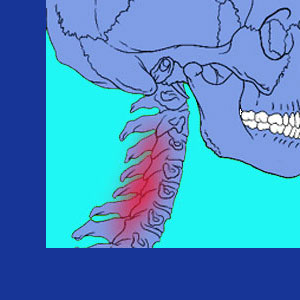
Cervical pain is also known as neck pain. The cervical spine is the uppermost region of the backbone and includes 7 vertebrae and 6 intervertebral discs. The anatomy of the C-spine is rather thin, light and delicate compared to the thoracic spine and the lumbar spine. However, the fact that it must support the incredible heft of the head throughout a rather huge and varied range of motion makes it very strong and flexible. Unfortunately, the constant bending and flexing of the cervical spine make it the second most common place in the spinal anatomy to suffer degenerative effects, bested only by the lumbar area.
This resource section details the exact locations and expressions of cervical symptoms. We will explore why patients have pain in different locations in the essays presented below.
Cervical Pain Essays
Here are many of the dedicated articles which deal with various locations that cervical spine pain occurs. If you have symptoms in a particular area of your neck, this is the place to look for information:
Pain in the neck is far more than a figure of speech. In fact, neck pain is the second most common type of dorsopathy and has reached truly epidemic proportions in the medical sector today.
Cervical spine pain describes generalized symptoms throughout the neck region. This condition is sometimes also known as cervical neck pain, although this term is a bit redundant.
Pain in back of neck is one of the most common types of neck ache and may exist unilaterally or bilaterally in the upper or lower neck areas.
Upper neck pain describes symptoms at the base of the skull and may include headache events.
Meanwhile, lower neck pain stands a greater chance of being caused by degeneration, since the lower cervical spine is the most often affected by spinal arthritis and various disc pathologies.
Pain in the side of the neck may exist on the right or the left and is almost always unilateral in nature.
Left side neck pain and right side neck pain are often muscular pain syndromes and neither is considered any worse, simply due to its location.
Pain in front of the neck is also called throat pain or frontal neck ache. These conditions rarely have anything to do with the cervical spine and are not usually related to a dorsopathy condition.
Pain in the back of head may be sourced by a cervical issue. Many patients report suffering from pain at the base of the head and radiating down one side of the neck. This is most typically tension-induced muscular pain.
Neck pain behind the ear may be related to a muscular issue, a cervical nerve issue or an ear condition.
Neck pain when looking down occurs because of flexion sensitivity. Learn why moving the chin to the chest can be so painful by reading our follow-up essay covering neck flexion pain. Meanwhile, although less commonly seen, some patients demonstrate neck extension pain when they look up.
Neck pain from pressure on the forehead is usually first noticed during a medical exam and can be rather frightening when symptoms are severe.
No matter what type of cervical pain you have, we can help. Our proprietary pain relief program can end pain quickly and is available immediately any time of day or night to help you right now.
Cervical Spinal Pain Locations
So many people write and mention that they have pain in a highly particular area of the neck, in the hopes that the location may help to ascertain the source. Unlike some pain syndromes, there is really no relevance to location-specific pain in the neck, unless it exists in the throat or frontal neck region. Back, side, upper and lower neck pain syndromes can all be sourced by the very same causative processes, so simply detailing the location of the pain will not help you to discover the true source.
We always recommend undergoing proper neck pain diagnosis in order to root out the true potential causes of neck pain and the best way to go about doing this is by using MRI technology to image the cervical spine.
Cervical Pain Help
We fully understand how horrible chronic pain can be in the neck, or anywhere else in the body, for that matter. When it all comes down to it, the location of the pain is not always crucial. What is important is its consequences on a person’s life and the misery it causes every patient. Remember, the location of the symptoms is directly linked to the source. If you discover the cause of the pain, then the symptoms will correlate. To this end, we strongly suggest concentrating on finding the actual reason why the pain exists, rather than burdening yourself further by overly researching the location of your pain and the relevance of the anatomical area affected. To accomplish this, you might need to enlist the help of more than one doctor. In fact, we routinely recommend consulting with a neurologist, an orthopedist and a physical therapist for any chronic pain concern.





